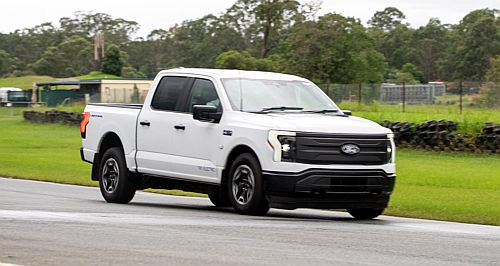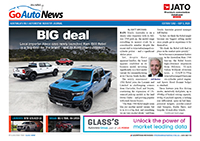Make / Model Search
News - AUSEV - F150 LightningRemanufactured F-150 Lightning targets minersBrisbane-based AUSEV claims HiLux-competitive TCO for RHD mine-spec Ford F-150 Lightning14 Apr 2025 QUEENSLAND vehicle remanufacturer AUSEV has officially launched Australia’s first right-hand drive 4x4 battery electric mining and construction ute, following months of testing on remote mine sites in Queensland and Western Australia, as well as the Lakeside Park motorsports facility near Brisbane.
The Brisbane-based company, which converts imported left-hand drive Ford F-150 Lightnings to right-hand drive for both the Australian and export markets, has delivered approximately 220 vehicles to date but expects significant growth as mining companies accelerate their emissions-reduction efforts.
Key to this will be total cost of ownership modelling promoted by AUSEV, which claims that remote mine sites could run a F-150 Lightning for five years at similar money to a diesel Toyota HiLux or Ford Ranger.
Speaking at a recent customer drive day at Lakeside Park, CEO of AUSEV parent company Bosscap Group, Edward Kocwa, said the vehicle was particularly relevant for the mining sector, which replaces approximately 20,000 light commercial vehicles annually from a total fleet of about 100,000 units.
“This market should be 1000 vehicles a year easy,” Mr Kocwa told GoAuto.
“We should get five per cent of that market for sure.”
He agreed that slowing F-150 Lightning demand in North America meant a free supply of donor vehicles for AUSEV, pointing out that another factor was the number of electric pickup competitors that had emerged in the Ford’s domestic market – while Australia’s push to decarbonise was more significant.
Unlike the Rivian R1T that is being sold into Australian mines by MEVCO as a left-hand drive proposition and cannot be purchased by the public, the RHD Ford can be purchased by anyone with the requisite budget (which GoAuto understands to be in the region of $175,000, or $25K more than a hybrid-powered Toyota Tundra).
Mr Kocwa was not expecting Ford Australia to pull the rug by introducing the F-150 Lightning through official channels as it has done with the petrol F-150, primarily due to the electric version not appealing to the retail market – especially ‘grey nomads’ – in the same way.
“The commercials don't stack up, in our opinion, for this to be done any other way,” asserted Mr Kocwa, adding that part of the right-hand-drive conversion method AUSEV had adopted would be difficult to replicate without infringing his company’s “registered design”.
“The way we do the steering, that’s a registered design. It cannot be done any other way. We had that registered,” he said, adding that Bosscap had assembled a high-calibre team including the likes of engineer Chris Fostineo, whose skills have previously been brought to bear at big-hitting remanufacturers like Premcar and RMAAA.
“This is not just an overnight idea. We've been working on this for many years. A lot of people are involved in this country and in the United States, and want to see it be a success,” said Mr Kocwa.
AUSEV’s mine-spec electric ute was developed through collaboration with local industry partners, including Brisbane-based tray manufacturer Allsafe Mine Vehicle Equipment (AMVE) and NSW-based GB Auto, which has been involved in converting Toyota LandCruisers to electric drivetrains for use on mine sites.
Mr Kocwa said GB Auto helped with electrical isolation as the company has “unique experience with auto electrical in the mining sector”.
He credited a partnership with resources industry light vehicle supply specialist Lewis Auto Hire as “changing the game” when cracking the mining fleet market.
“Getting into the mining sector is not easy; they’re large corporations of 10,000 people, so to make a decision when it’s capital expenditure is a long job,” he explained.
“Lewis Auto Hire came on board, ran the vehicles, went to their customers and said, ‘instead of taking Prados, take the EVs’ – and it’s worked.”
Mr Kocwa mentioned resources giants Rio Tinto and Fortescue as operators now running F-150 Lightnings courtesy of Lewis Auto Hire, as well as mining contractor Linkforce among others.
“Sometimes you just need a circuit-breaker when you’re going against the mould and trying something different, you need to find a way through and these guys (Lewis Auto Hire) have honestly changed the game for us; the vehicles are on site and now the phones are ringing, so we really appreciate that,” he added.
Bosscap Group chief financial officer Tom Shipsides told attendees that when considering the total cost of ownership (TCO), including energy costs, maintenance expenses, and residual values, the F-150 Lightning proved more economical than popular diesel alternatives like the Toyota HiLux.
“When we’re looking at these assets, if all you’re doing is looking at the list pricing, going, ‘Oh, that’s expensive, or that’s cheap,’ you're probably getting this wrong,” said Mr Shipsides.
“As organisations, you need to be looking at what is the total cost of the asset over the term which you hold that asset. We’re talking maintenance, we’re talking fuel, we’re talking energy, we’re talking insurance. Of course, we’re talking the list price, and of course, we’re talking the residual.”
The company’s TCO analysis showed that running an F-150 Lightning would be similar to that of a HiLux over a typical four-year ownership period with approximately 20,000km travelled annually and a 40 per cent residual value.
He clarified that the F-150 Lightning’s higher-than-average predicted residual value was due to the anticipated “mad scramble” to decarbonise fleets at the end of this decade, and that a number of leasing companies had accepted this theory.
Compared against models bearing the LandCruiser badge, the claimed numbers looked even more favourable to the F-150.
Mr Kocwa said the “basic economics of that TCO have been proven with a couple of tier ones in the Pilbara”.
“They need it to make financial sense, and when they did all the numbers, they worked out the money they saved by not having to transport diesel on site, it won out against the HiLux and the Ranger,” he said.
Beyond fuel transport and storage on remote sites, Mr Kocwa said the lack of tailpipe emissions from the likes of the F-150 Lightning meant mining companies stood to reduce the cost of ventilation requirements in underground operations.
“Once they’ve transitioned, the cost will come down dramatically … The quicker you can transition to full EV means that you don'’ need the mechanical workshops and all those things, and life gets a lot easier,” he said.
Beyond mining applications, Mr Kocwa said there had been unexpected interest from Australian farmers, who appreciated the vehicle’s ability to be charged from solar installations and operate as mobile power stations.
He said part of the appeal was the self-sufficiency of being able to fuel a vehicle using solar energy produced on-site, which is seen as providing an energy security buffer against reliance on reserves of imported oil.  Read more |
Click to shareAUSEV articlesMotor industry news |











Facebook Twitter Instagram